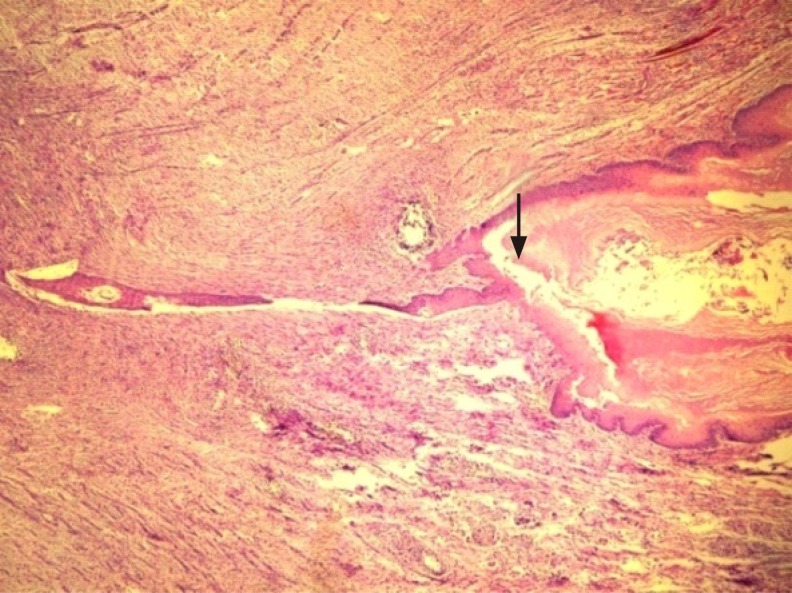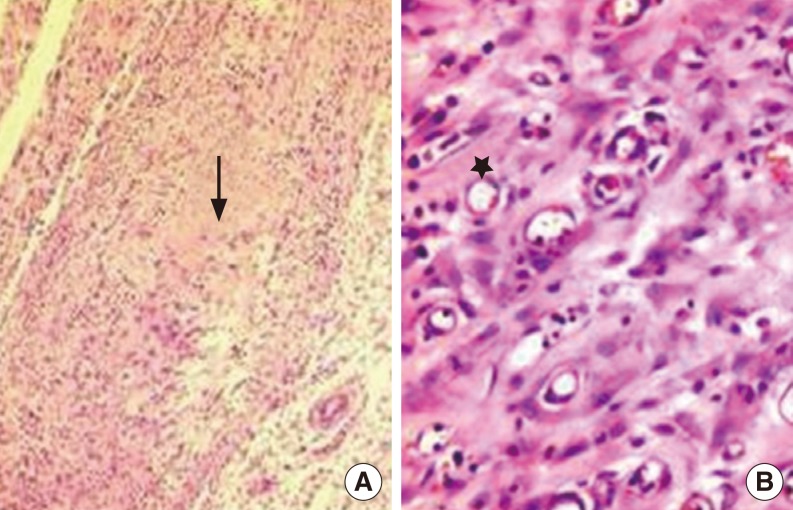Clin Exp Otorhinolaryngol.
2015 Dec;8(4):390-395. 10.3342/ceo.2015.8.4.390.
Effectiveness of Recombinant Human Growth Hormone for Pharyngocutaneous Fistula Closure
- Affiliations
-
- 1Department of Otolaryngology-Head and Neck Surgery, Marmara University Faculty of Medicine, Istanbul, Turkey. drnurten@yahoo.com.tr
- 2Department of Pathology, Bahcesehir University Faculty of Medicine, Istanbul, Turkey.
- KMID: 2128916
- DOI: http://doi.org/10.3342/ceo.2015.8.4.390
Abstract
OBJECTIVES
In laryngeal cancer, which comprises 25% of head and neck cancer, chemotherapy has come into prominence with the increase in organ-protective treatments. With such treatment, salvage surgery has increased following recurrence; the incidence of pharyngocutaneous fistula has also increased in both respiratory and digestive system surgery. We investigated the effects of recombinant human growth hormone on pharyngocutaneous fistula closure in Sprague-Dawley rats, based on an increase in amino acid uptake and protein synthesis for wound healing, an increase in mitogenesis, and enhancement of collagen formation by recombinant human growth hormone.
METHODS
This study was experimental animal study. Forty Sprague-Dawley rats were separated into two groups, and pharyngoesophagotomy was performed. The pharyngoesophagotomy was sutured with vicryl in both groups. Rats in group 1 (control group) received no treatment, while those in group 2 were administered a subcutaneous injection of recombinant human growth hormone daily. On day 14, the pharynx, larynx, and upper oesophagus were excised and examined microscopically.
RESULTS
Pharyngocutaneous fistula exhibited better closure macroscopically in the recombinant human growth hormone group. There was a significant difference in collagen formation and epithelisation in the recombinant human growth hormone group compared to the control group.
CONCLUSION
This study is believed to be the first in which the effect of recombinant human growth hormone on pharyngocutaneous fistula closure was evaluated, and the findings suggest the potential of use of growth hormone for treatment of pharyngocutaneous fistula.
Keyword
MeSH Terms
-
Animals
Collagen
Digestive System
Drug Therapy
Fistula*
Growth Hormone
Head and Neck Neoplasms
Human Growth Hormone*
Humans*
Incidence
Injections, Subcutaneous
Laryngeal Neoplasms
Larynx
Pharynx
Polyglactin 910
Rats
Rats, Sprague-Dawley
Recurrence
Wound Healing
Collagen
Growth Hormone
Human Growth Hormone
Polyglactin 910
Figure
Reference
-
1. Aslam MJ, Ahmed Z, Aslam MA, Ahmed MI. Complications of total laryngectomy. Pak J Med Sci. 2006; Jan-Mar. 22(1):33–37.2. Virtaniemi JA, Kumpulainen EJ, Hirvikoski PP, Johansson RT, Kosma VM. The incidence and etiology of postlaryngectomy pharyngocutaneous fistulae. Head Neck. 2001; 1. 23(1):29–33.
Article3. Palomar-Asenjo V, Sarroca Capell E, Tobias Gomez S, Perez Hernandez I, Palomar-Garcia Garcia V. Pharyngocutaneous fistula following total laryngectomy: a case-control study of risk factors implicated in its onset. Acta Otorrinolaringol Esp. 2008; 12. 59(10):480–484. PMID: 19080783.4. Ganly I, Patel S, Matsuo J, Singh B, Kraus D, Boyle J, et al. Postoperative complications of salvage total laryngectomy. Cancer. 2005; 5. 103(10):2073–2081. PMID: 15816049.
Article5. Grau C, Johansen LV, Hansen HS, Andersen E, Godballe C, Andersen LJ, et al. Salvage laryngectomy and pharyngocutaneous fistulae after primary radiotherapy for head and neck cancer: a national survey from DAHANCA. Head Neck. 2003; 9. 25(9):711–716. PMID: 12953306.6. Gu Y, Wu ZH, Xie JX, Jin DY, Zhuo HC. Effects of growth hormone (rhGH) and glutamine supplemented parenteral nutrition on intestinal adaptation in short bowel rats. Clin Nutr. 2001; 4. 20(2):159–166. PMID: 11327744.
Article7. Guntinas-Lichius O, Eckel HE. Temporary reduction of salivation in laryngectomy patients with pharyngocutaneous fistulas by botulinum toxin A injection. Laryngoscope. 2002; 1. 112(1):187–189. PMID: 11802061.
Article8. Wiseman S, Hicks W Jr, Loree T, Al-kasspooles M, Rigual N. Fibrin glue-reinforced closure of postlaryngectomy pharyngocutaneous fistula. Am J Otolaryngol. 2002; Nov-Dec. 23(6):368–373. PMID: 12430130.
Article9. Guyton AC, Hall JE, editors. Textbook of medical physiology. 10th ed. Philadelphia: Saunders;2000.10. Lissett CA, Shalet SM. Effects of growth hormone on bone and muscle. Growth Horm IGF Res. 2000; 4. 10(Suppl B):S95–S101. PMID: 10984262.11. Veldhuis JD, Anderson SM, Shah N, Bray M, Vick T, Gentili A, et al. Neurophysiological regulation and target-tissue impact of the pulsatile mode of growth hormone secretion in the human. Growth Horm IGF Res. 2001; 6. 11(Suppl A):S25–S37. PMID: 11527085.12. Çapan MY, Yuksek MS, Akcay MN, Onay T, Atamanalp SS, Uslu S, et al. Metabolic and endocrine changes after open and laparoscopic cholecyctectomies. New J Med. 1997; 14(Suppl 1):15–17.13. Wilmore DW. Postoperative protein sparing. World J Surg. 1999; 6. 23(6):545–552. PMID: 10227922.
Article14. Jarrar D, Wolf SE, Jeschke MG, Ramirez RJ, DebRoy M, Ogle CK, et al. Growth hormone attenuates the acute-phase response to thermal injury. Arch Surg. 1997; 11. 132(11):1171–1175. PMID: 9366708.
Article15. Ramirez RJ, Wolf SE, Herndon DN. Is there a role for growth hormone in the clinical management of burn injuries? Growth Horm IGF Res. 1998; 4. 8(Suppl B):99–105. PMID: 10990141.
Article16. Harrison LE, Port JL, Hochwald S, Blumberg D, Burt M. Perioperative growth hormone improves wound healing and immunologic function in rats receiving adriamycin. J Surg Res. 1995; 6. 58(6):646–650. PMID: 7791342.17. Atkinson JB, Kosi M, Srikanth MS, Takano K, Costin G. Growth hormone reverses impaired wound healing in protein-malnourished rats treated with corticosteroids. J Pediatr Surg. 1992; 8. 27(8):1026–1028. PMID: 1403528.
Article18. Shaw NJ, Fraser NC, Rose S, Crabtree NJ, Boivin CM. Bone density and body composition in children with growth hormone insensitivity syndrome receiving recombinant IGF-I. Clin Endocrinol (Oxf). 003; 10. 59(4):487–491. PMID: 14510912.
Article19. O'Hara J, Lock C, Paleri V, Wight R. Oral feeding regimes following laryngectomy: a qualitative study of consultants' opinions in the North of England. Oral Oncol. 2009; 8. 45(8):727–730. PMID: 19147395.20. Kucuk B, Yorulmaz I. Pectoralis major myocutaneous flap and deltopectoral flap reconstruction of a huge defect caused by pharyngocutaneous fistula. Istanbul Soc Otolaryngol Head Neck Surg. 2000; 8(2):108–114.21. Mathes SJ, Nahai F, editors. Reconstructive surgery: principles, anatomy and technique. New York: Churchill Livingstone;1997.22. Lee SW, Kim SH, Kim JY, Lee Y. The effect of growth hormone on fibroblast proliferation and keratinocyte migration. J Plast Reconstr Aesthet Surg. 2010; 4. 63(4):e364–e369. PMID: 20022575.
Article23. Jeschke MG, Herndon DN, Finnerty CC, Bolder U, Thompson JC, Mueller U, et al. The effect of growth hormone on gut mucosal homeostasis and cellular mediators after severe trauma. J Surg Res. 2005; 8. 127(2):183–189. PMID: 16083754.
Article24. Gu GS, Ren JA, Li N, Li JS. Effects of recombinant human growth hormone on enterocutaneous fistula patients. World J Gastroenterol. 2008; 11. 14(44):6858–6862. PMID: 19058314.
Article25. Souza FM, Collett-Solberg PF. Adverse effects of growth hormone replacement therapy in children. Arq Bras Endocrinol Metabol. 2011; 11. 55(8):559–565. PMID: 22218437.
Article26. Renehan AG, Brennan BM. Acromegaly, growth hormone and cancer risk. Best Pract Res Clin Endocrinol Metab. 2008; 8. 22(4):639–657. PMID: 18971124.
Article
- Full Text Links
- Actions
-
Cited
- CITED
-
- Close
- Share
- Similar articles
-
- Effect of yeast-derived methionyl recombinant growth hormone on growth hormone deficient dwarf
- Clinical Analysis of Pharyngocutaneous Fistula
- The pharmacokinetics and biological effects of yeast derived recombinant methionyl growth hormone in growth hormone deficient children
- Usefulness of Endoluminal Vacuum-Assisted Closure Therapy for Pharyngocutaneous Fistula
- Modified Continuous Mucosal Connell Suture for the Pharyngeal Closure After Total Laryngectomy: Zipper Suture










